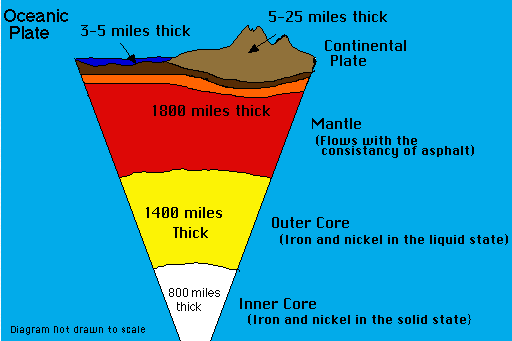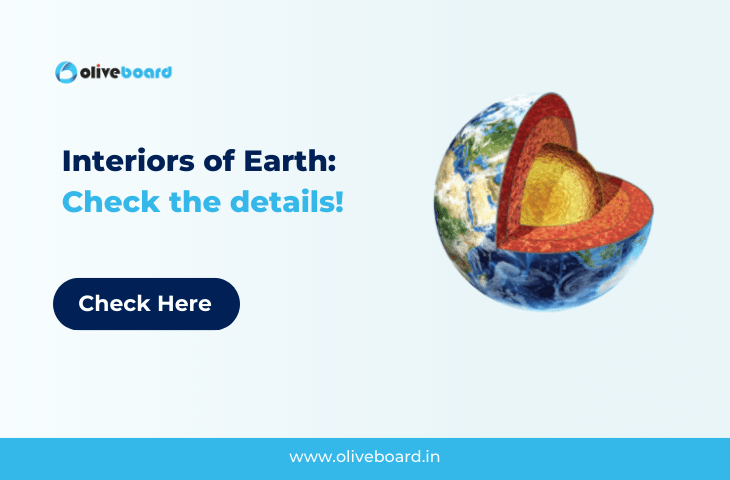Interior of the Earth: Geography is a vast subject and often creates hurdles for candidates. The Interior of the earth is an important topic for UPSC CSE preparation. Candidates need to have a depth knowledge to understand this topic properly. In this blog, we will provide you with the details of each aspect of the interior of the earth.

Earth has 3 major layers namely:
- Crust
- Mantle
- Core (Outer Core & Inner Core)
Internal layers of the earth
The radius of the earth is 6,370 km. Thus, it is impossible to reach the center of the earth and find out about the composition. Also, this composition is changing in nature. The rapid increase in temperature is also one of the factors that put a limit to direct observation of the earth’s interior.
Sources of information are of two types: Direct & Indirect.
Some Direct Sources:
- Rocks (Mining)
- Volcanic Eruptions
Some Indirect Sources:
- Rate of change of temperature and pressure from the surface towards the interior
- Gravitation
- Gravity anomaly (gravity changes according to the mass of material thus giving us information about the materials in the earth’s interior).
- Meteors (they are made up of similar materials as earths)
- Seismic Waves (the shadow zones of body waves give us information about the state of materials in the interior)
- Magnetism
The Crust
- Earth’s hard outer layer is brittle in nature. It is less than 1% of Earth’s volume. The crust is made up of different types of rocks: igneous, metamorphic, and sedimentary rocks.
- The crust is of two different types. One is the continental crust (under the land) and the other is the oceanic crust (under the ocean).
- The continental crust has an upper part called granitic rock and forms the continents. Silica and alumina (Sial) are their main constituents.
- The lower part has basaltic rock forming the Oceanic floor. Silica, iron, and magnesium (Sima) are its main constituents.
- The thickness of the crust varies from 5 to 70 kilometers. The continental crust is thicker, and the oceanic crust is thinner. The mean thickness of the oceanic crust is 5 km whereas that of the continental is around 30 km.
- The temperature of the crust increases with depth because of geothermal energy. Where the crust meets the mantle the temperatures can be between 200 °C (392 °F) to 400 °C (752 °F). The crust is the coldest among all layers because it is exposed to the atmosphere.
- The oldest oceanic basalt crust today is only about 200 million years. Most of the continental crust is much older. The oldest continental crustal rocks on Earth are cratons between 3.7 to 4.28 billion years old.
The Mantle
- The mantle is the mostly-solid bulk of Earth’s interior. The mantle lies between Earth’s dense, super-heated core and its thin outer layer, the crust. The mantle is about 2,900 kilometers (1,802 miles) thick and makes up a whopping 84% of Earth’s total volume.
- It is composed mainly of dense rocks rich in olivine.
- The rocks that makeup Earth’s mantle are mostly silicates—a wide variety of compounds that share a silicon and oxygen structure. Common silicates found in the mantle include olivine, garnet, and pyroxene. The other major type of rock found in the mantle is magnesium oxide. Other mantle elements include iron, aluminum, calcium, sodium, and potassium.
- The temperature of the mantle varies greatly, from 1000° Celsius (1832° Fahrenheit) near its boundary with the crust, to 3700° Celsius (6692° Fahrenheit) near its boundary with the core. In the mantle, heat and pressure generally increase with depth.
- The transfer of heat and material in the mantle helps determine the landscape of Earth. Activity in the mantle drives plate tectonics, contributing to volcanoes, seafloor spreading, earthquakes, and orogeny (mountain-building).
- The upper portion of the mantle is called the asthenosphere extending up to 400 km. It is the main source of magma and has a density higher than the crusts.
- Repetti discontinuity separates the outer and the inner mantle. The lower mantle extends beyond the asthenosphere. It is in a solid state.
The Core
- The Earth’s core is the central inner part of our planet. It has a solid inner core and a liquid outer core.
- The outer core of the Earth is a liquid layer about 2,260 kilometers thick. It is made of iron and nickel.
- Accounts for 16 percent of the earth’s volume.
- Core has the heaviest mineral materials of the highest density.
- Its outer boundary is 2,890 km (1,800 mi) beneath the Earth’s surface. The transition between the inner core and outer core is approximately 5,000 km (3,100 mi) beneath the Earth’s surface.
- The temperature of the outer core ranges from 4400 °C in the outer regions to 6100 °C near the inner core. Eddy currents in the nickel-iron fluid of the outer core are believed to influence the Earth’s magnetic field.
- The average magnetic field strength in the Earth’s outer core was measured to be 25 Gauss, 50 times stronger than the magnetic field at the surface
- Without the outer core, life on Earth would be very different. The convection of liquid metals in the outer core creates the Earth’s magnetic field. This magnetic field extends outward from the Earth for several thousand kilometers and creates a protective bubble around the Earth that deflects the Sun’s solar wind.
- The inner core of the Earth, as detected by seismology, is a solid sphere about 1,216 km (760 mi) in radius, or about 70% of that of the Moon. It is believed to be an iron-nickel alloy and may have a temperature similar to the Sun’s surface, approximately 5778 K (5505 °C).
- Indian Bank Recruitment 2025 Out for 1500 Apprentice Posts
- Indian Bank Apprentice Salary 2025, Pay Scale, Salary Structure
- Indian Bank Apprentice Syllabus & Exam Pattern 2025, Check Details
- Railway RPF Syllabus 2024, Check Exam Pattern, Topic And Syllabus
- SSC JE vs RRB JE, Which Is Better? Know Detailed Comparison

The most comprehensive online preparation portal for MBA, Banking and Government exams. Explore a range of mock tests and study material at www.oliveboard.in
